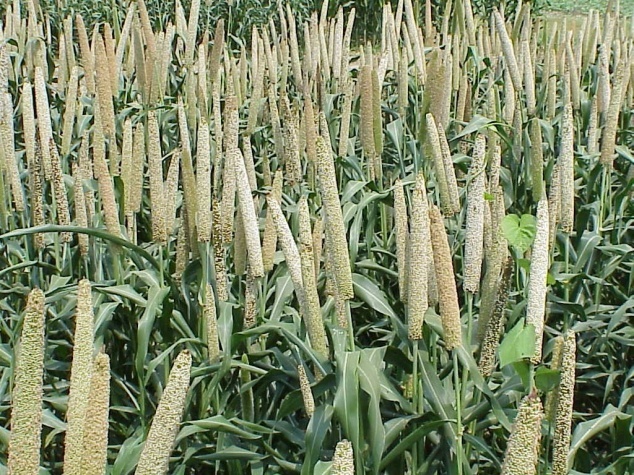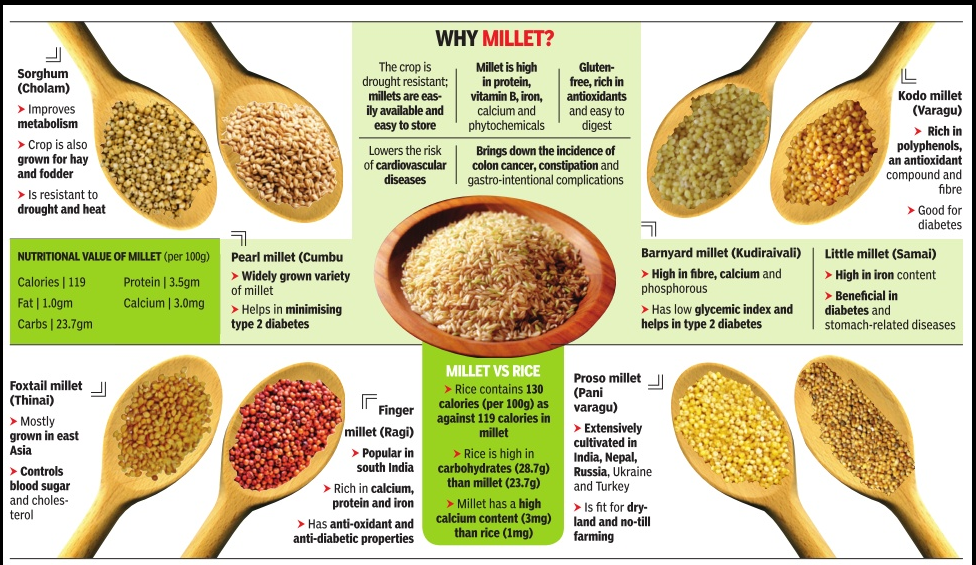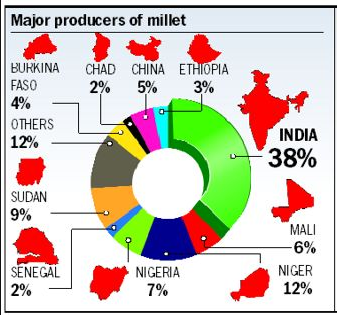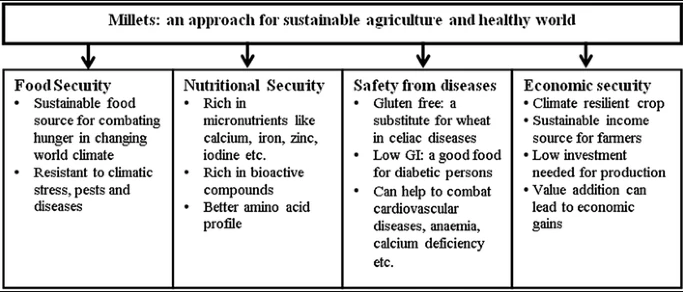
Disclaimer: Copyright infringement not intended.
Context
- Union Minister of State for M/o Food Processing Industries, inaugurated the National Conference on Millets.
- The theme was ‘The Future Super Food for India' in New Delhi. The Conference was organized by industry body ASSOCHAM with the support of M/o Food Processing Industries.
- The conference has been organised to discuss opportunities and challenges in ensuring food and nutritional security.
About Millets
- Millets are cereal crops with high nutritive value and categorized as small-seeded grasses.
- The key varieties of millets include Sorghum, Pearl Millet, Ragi, Small Millet, Foxtail Millet, Barnyard Millet, Kodo Millet and others.
- Major producers include Rajasthan, Andhra Pradesh, Telangana, Karnataka, Tamil Nadu, Maharashtra, Gujarat and Haryana.

- High in dietary fibre, nutri-cereals are a powerhouse of nutrients including iron, folate, calcium, zinc, magnesium, phosphorous, copper, vitamins and antioxidants.

Major Millet Producing States in India
- Punjab
- Uttar Pradesh
- Andhra Pradesh
- Himachal Pradesh
- Sikkim
- Chhattisgarh
- Tamil Nadu
- Karnataka
- Kerala
- Haryana
- Uttarakhand
- Telangana
- Jharkhand
- Rajasthan
- Maharashtra
- Gujarat
Conditions required for growing Millet
|
Millet Name
|
Description
|
|
Sorghum millet/Jowar
|
Climate- Warm, arid.
Rainfall- 45-100 cms.
Temperature- 20-35 degrees Celsius.
Soil- Sandy, loamy, good drainage; pH-6-7.5.
Largest producer- Maharashtra.
|
|
Finger millet/Ragi
|
Climate- High altitude, extreme conditions.
Rainfall- 70-120cms.
Temperature- 25-30 degrees Celsius.
Soil- Red,black,sandy,loamy and lateritic;pH-4.5-8.
Largest producer- Karnataka.
|
|
Pearl millet/Bajra
|
Climate- Moist conditions, without irrigation.
Rainfall- 40-50cms .
Temperature- 20-30 degrees Celsius.
Soil- Black cotton, sandy, loamy, upland gravely, good drainage; pH-low.
Largest producer-Rajasthan.
|
|
Foxtail millet/Kangni
|
Climate-Warm, arid, tropical region.
Rainfall-50-75cms.
Temperature- 15-30 degrees Celsius.
Soil- Sandy,loam ;pH-5.5-7
Largest producer-Andhra Pradesh.
|
|
Barnyard millet/Sanwa
|
Climate- Tropical, subtropical, high altitude.
Rainfall-60-80cms.
Temperature-18-27 degree Celsius.
Soil- sandy,loam;pH-5.5-7.5.
Largest producer-Himalayan hills.
|
|
Kodo millet/Kodon
|
Climate-Warm, dry, extremely drought-tolerant.
Rainfall-50-60cms.
Temperature- 26-29 degrees Celsius.
Soil-Gravelly, stony, hilly; pH-5.5-7.5.
Largest producer-Madhya Pradesh
|
|
Proso millet/Chena
|
Climate-Warm, arid,non-irrigated.
Rainfall-20-50cms.
Temperature-10-45 degree Celsius.
Soil-Many types;pH-5.5-6.5.
Largest producer- Madhya Pradesh.
|
Importance of millets for Environment and Climate Change
- Millets are known for their climate-resilient features including adaptation to a wide range of ecological conditions, less irrigational requirements, better growth and productivity in low nutrient input conditions, less reliance on synthetic fertilizers, and minimum vulnerability to environmental stresses
- Millets can counter many of the adverse effects of climate change better than most other food crops. They grow in almost any type of soil – sandy or with varying levels of acidity. They hardly need any fertilisers or irrigation.
- The inter-cropping of millets with other crops is especially beneficial because the fibrous roots of millet plants help in improving soil quality, keep water run-off in check and aid soil conservation in erosion-prone areas, thereby restoring natural ecosystems.
- Being hardy crops, they can withstand extreme temperatures, floods and droughts. Being a C4 group of cereals, millets convert more carbon dioxide to oxygen, contributing in mitigating climate change through their low carbon footprint of 3,218-kilogram equivalent of carbon dioxide per hectare, as compared to wheat and rice, with 3,968kg and 3,401kg, respectively, on the same measure.
- Thus, millets can help to phase out climatic uncertainties, reducing atmospheric carbon dioxide, and can contribute in mitigating the climate change.
Biofuel and Climate Resilience
- Recently, the deadline for achieving 20% ethanol blending with petrol has been set for 2025 - a measure aimed at the reduction of carbon emissions from the combustion of fossil fuels.
- Most bio-ethanol in India is produced using sugar molasses and maize. However, a study conducted among farmers in Madhya Pradesh showed that bio-ethanol can be created using sorghum (jowar) and pearl millet (bajra), and that this fuel could bring down carbon emissions by about half.
- Millets also offer a significant cost advantage over maize as a feedstock for bio-ethanol production. Estimates also suggest that millets can deliver greater returns than maize, while using 40% less energy in processing.
Agrarian Importance of Millets for Farmers
- Dry lands constitute 40% of the global land surface and are home for about 1/3rd of the global population.
- These low fertile soils are predicted to elevate up to 50–56% in 2100 AD, and 78% of dry land expansion is expected to occur in developing countries.
- Increasingly erratic rainfall patterns and crop losses due to climate change factors has affected farmers tremendously.
- The spate of farmer’s suicides in an agriculture-based country like India has reached to an average of 52 deaths/day, and reports of farmers selling their blood to earn a livelihood in drought-hit region of the country depict the severity of the agrarian crisis.
- There is a lesser possibility of increasing the production of major staple cereals as the world is already facing the challenges of increase in dry lands and deepening of ground water level .
- According to the report of the National Rainfed Area Authority (NRAA) even after realizing the full irrigation potential, about half of the net sown area will continue to remain rainfed .This alarms the need of shifting to the alternative of current cereal staples.
- The need of the hour is to adapt to climate change by switching from water-intensive rice, sugarcane and maize cultivation to various types of drought-resistant millets
- Millets cultivation can be a solution to this problem as these can grow on shallow, low fertile soils with a pH of soil ranging from acidic 4.5 to basic soils with pH of 8.0. Millets can be a good alternative to wheat especially on acidic soils.
- Unlike rice and wheat that require many inputs in terms of fertiliser and water, millets grow well in dry regions as rain-fed crops.
- Therefore, boosting millet cultivation will empower the average farmer and achieve the objectives of enhancing incomes and improving crop diversification.

Challenges with Millet Cultivation in India
- No market to sell millet crops: In some village areas farmers are not getting the do not get the market to sell their crops. To sell crops in bulk they have to locate certain small shops since there is no profitable market or demand nearby. This also makes the distribution of crops difficult.
- Low bulk prices of Millets in India and high MRP: Farmers get a low pay for millets which urges them to lower millet production and grow other crops instead to earn a better income. However, since the MRP for millets is high, the public usually prefers buying other cheaper grains instead.
- Government schemes and efforts are unable to reach the farmers: All schemes and plan benefits are limited to the big cities, due to which farmers are not at all aware of the programs.
- Low crop productivity and high labor intensity: Cultivating millets requires strong manual labor and is difficult for a single person to do. Added to this is the fact that certain millets turn out to be low in productivity.
- Difficult post-harvest operations add to these problems.
- Easy availability of other grains: such as rice due to a good network of Public Distribution System gives tough competition for the demand of millets in India. This causes grains such as rice to be established as the staple food in a region.
- Lack of know-how on ways to use small millets in the daily diet/staple diet across the country is widespread.
- Lack of investment in millet product development and promotion/ advertisements.
- Improper suitable processing units close to millet fields: causes local producers to take their produce to distant places. For example, raw grains of Kodo millets produced in Tamil Nadu, need to be transported to Maharashtra for processing.
Measures being taken to promote Millet: A multi-pronged strategy
APEDA
- The APEDA is also working in collaboration with the Department of Agriculture and Farmers Welfare to increase cultivation area, production and productivity of millets, including bajra, jowar and ragi.
Millets as Nutricereals
- In view of the nutritional value of the millets, the government has notified millets as nutri-cereals in April, 2018. The millets are a rich source of protein, fibre, minerals, iron, calcium and have a low glycemic index.
International Year of Millets
- In March, 2021, the United Nations General Assembly (UNGA) has declared 2023 as International Year of Millets.
- Intensive Millets Promotion(INSIMP): Launched in 2012 as a part of the Rashtriya Krishi Vikas Yojana(RKVY), to advance equipment and technology related to millet harvest and increasing productivity of inefficient areas.
Rainfed Area Development Programme
- Developing and identifying new areas receiving adequate rainfall for millet farming as a part of the Rashtriya Krishi Vikas Yojana(RKVY).
Re-branding of coarse cereals/millets as nutri-cereals.
- Till 2018-19, millet production was extended to over 14 states.
MSP of nutri-cereals
- Next, the government hiked the MSP of nutri-cereals, which came as a big price incentive for farmers. As we compare the data on MSPs for food crops from 2014-15 against 2020, we see that the MSP for ragi has jumped a whopping 113 per cent, followed by bajra and jowar at 72 per cent and 71 per cent respectively. MSPs have been calculated so that the farmer is ensured at least a 50 per cent return on their cost of production.
National Food Security Mission
- Millets are being promoted under the National Food Security Mission (NFSM) to help provide good nutrition to those who are unable to afford it. To provide a steady market for the produce, the government included millets in the public distribution system.
Efforts by Ministry of Agriculture & Farmers’ Welfare
- Next the Ministry of Agriculture & Farmers’ Welfare is running a Rs 600-crore scheme to increase the area, production and yield of nutri-cereals.
- With a goal to match the cultivation of nutri-cereals with local topography and natural resources, the government is encouraging farmers to align their local cropping patterns to India’s diverse 127 agro-climatic zones.
Building Value Chains
- Provision of seed kits and inputs to farmers, building value chains through Farmer Producer Organisations and supporting the marketability of nutri-cereals are some of the key interventions that have been put in place.
“Millet in Minutes” products:
- Recently APEDA launched a variety of “Millet in Minutes” products under the category of Ready-to-Eat (RTE) such as Upma, Pongal, Khichadi, Noodles, Biryani, etc, This is a breakthrough in the food sector as it’s the first RTE millet product in the market to cater fast-paced world at their convenience in a healthy way. All the millet products launched by APEDA are gluten-free, 100% natural and patented. All the RTE products are vacuum processed without any additives, fillers and preservatives. Nutrition value is retained as original with a shelf-life of 12 months in ambient temperature.
Nutri-Gardens and Behaviour Change Campaign
- The Ministry of Women and Child Development has been working at the intersection of agriculture and nutrition by setting up nutri-gardens, promoting research on the inter-linkages between crop diversity and dietary diversity and running a behaviour change campaign to generate consumer demand for nutri-cereals.
LetsMilletCampaign in Bengaluru
- In 2018, the #LetsMilletCampaign in Bengaluru saw the avant-garde use of millets in dishes such as risotto and pizza by restaurateurs.
Cultural associations and festivals
- Cultural associations and festivals, such as the North-East Network in Nagaland organized in 2020 and Mandukiya in Vishakhapatnam celebrated annually in June/July, has helped promote the growth of millets.
Integrated Cereals Development Programmes in Coarse Cereals
- The government also initiated the ‘Integrated Cereals Development Programmes in Coarse Cereals’ under Macro Management of Agriculture.
Conversion of Fallow Lands
- The government of Tamil Nadu is converting fallow and wastelands into millet farms.
- The government of Orissa is trying to increase the land area for millet production.
Efforts by Indian Institute of Millet Research
- The Indian Institute of Millet Research, the International Crops Research Institute for the Semi-Arid Tropics and the government of Karnataka are going to collaborate along with more partners to promote millets in India.
Other State Govt. efforts
- Apollo hospitals in Hyderabad signed a memorandum of understanding with Deccan Development Society to incorporate millet in their hospital diets. This is likely to benefit 5,000 women farmers.
- The government of Karnataka, similarly, proposed inclusion millets in school mid-day meal programmes.
- Government of Maharashtra has announced subsidies for millets.
- The government of Karnataka is encouraging the drought-struck farmers to shift from water-intensive crops to harvesting millets.
Because of initiatives of the government, production of millets increased from 14.52 million tonnes in 2015-16 to 17.96 million tonnes in 2020-21 and the production of Bajra has also increased from 8.07 million tonnes to 10.86 million tonnes during the same period.
|
Case Study: Dindori Model
An International Fund for Agricultural Development (IFAD) has supported an initiative to revive kodo and kutki cultivation in Dindori district of Madhya Pradesh. The project was started in 2013-14, with 1,497 women-farmers from 40 villages — mostly from the Gonda and Baiga tribes — growing these two minor millets on 749 acres. The recognized farmers had been equipped good-quality seeds and skilled by scientists from the Jawaharlal Nehru Agricultural College in Jabalpur and the native Krishi Vigyan Kendra — on subject preparation, line-sowing (versus standard broadcasting by hand) and software of compost, zinc, bavastin fungicide and different particular safety chemical compounds.
Additional, a federation of farmers’ self-help teams undertook procurement of the produce and mechanical de-hulling — the normal guide pounding course of to take away husk from the grain was time-consuming. The variety of farmers rising kodo-kutki has risen to 14,301 in 2019-20. So has the overall acreage to 14,876 acres. The IFAD project thus helped in meeting nutritional goals and reviving millet cultivation.
|
Suggestions
Nutrition Ambassadors and Entrepreneurs
- Grassroots workers like the anganwadi and ASHA workers must be further involved as nutrition ambassadors and entrepreneurs in the millet revolution.
Creation of an attractive value chain
Collaborations with schemes like National Rural Livelihoods Mission and focus on the creation of an attractive value chain are needed. Techniques in packaging and processing must precede efforts to target metropolitan cities and urban centers to create more demand. Promotion of processed millet products such as ragi cookies, bajra biscuits, jowar namkeen.
India Millets Mission
- An inclusive rural economy can be built around millets by promoting entrepreneurial ventures through the India Millets Mission. Similarly, initiatives around appropriate pricing must be undertaken.
Training and capacity-building initiatives
- The need of the hour is Dedicated programmes with proper training and capacity-building initiatives that urge farmers to move away from loss-making crops toward diversification via millets.
‘Vocal for Local’ campaign
- There is an imported penetration of seeds, whole grains and cereals not native to the Indian geography or cuisine. Quinoa is a prominent example that has seen increasing domination in urban diets. Hence, under the ‘Vocal for Local’ campaign, indigenous crops must be lent more support and focus.
Empower women farmers
- Empower women farmers and self-help groups (SHG), by equipping them with advanced packaging techniques, agro-marketing, financial literacy and other entrepreneurial skills.
Introducing millet cultivation in areas where farmers’ distress is visible
- One way to double farm incomes and encourage farm diversification is to make millet production attractive by introducing millet cultivation in areas where farmers’ distress is visible.
- For instance, the cotton dependency of Vidarbha's farmers and economy is well-known, especially in the arid zones. The region in Maharashtra is also known as the farmer suicide capital.
- Perhaps one of the most important solutions is to encourage cotton farmers to diversify into millet production after careful feasibility studies and feedback from the farmers themselves.
Final Thoughts
- Since the outbreak of the novel coronavirus disease (COVID-19), ‘immunity foods’ have gained traction. In this context, micro-nutrient-rich millets are suitable substitutes for reviving our traditional food systems and maintaining ecological harmony with nature.
- Millet cultivation clearly needs state support. The Odisha Millet Mission, for example, has reportedly managed to motivate about 70,000 farmers to take up millet farming as part of this programme. Initiatives such as these will encourage millet production and help address micronutrient deficiency and promote concepts like nutrition entrepreneurship.
https://www.pib.gov.in/PressReleasePage.aspx?PRID=1836530
https://www.downtoearth.org.in/blog/agriculture/how-millet-production-can-empower-women-farmers-strengthen-agriculture-76293
1.png)















